Call Us
+91 9326762293Email Us
contact@chakrayog.comAll About 7 Chakra Symbols & Their Meaning: A Complete Overview of Chakra Symbols and Their Significance in Spiritual Healing
All About 7 Chakra Symbols & Their Meaning: A Complete Overview of Chakra Symbols and Their Significance in Spiritual Healing
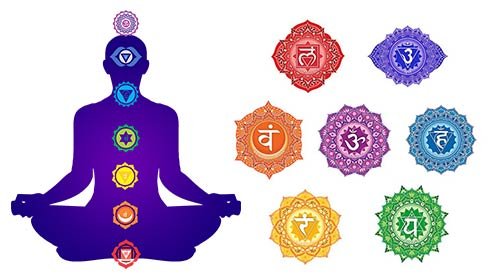
It has long been held that seven primary chakras run along the spine, from the tailbone to the top of the head. Each of the seven chakras embodies distinctive characteristics and energies. The chakra symbols are a type of sacred depiction of these different energy centers that combine imagery, geometric shapes, Sanskrit letters, sacred sounds, colors and symbolic animals which reverberate with each chakra’s energy. They all combined represent the energy of each chakra and also have profound spiritual significance.
The forms of the chakra symbols date back to the five emblems of Yagna utilized in Vedic rites. Square, circle, triangle, half-moon, and dumpling are the five emblems of Yagna. The first five primary chakras correspond to the elements of fire, water, earth, ether, and air.
The symbol refers to the physical form of the chakra, which consists of petals of the lotus flower that surround each chakra with a precise number of petals to symbolize it. Like a yantra, which is also known as a “machine,” aids in illustrating the operation of the chakras.
Circles symbolize perpetual motion and the cyclical nature of energy. Each chakra symbol features a circle, since when all of our chakras are balanced, we experience a sense of completeness and harmony. Chakra is the Sanskrit term meaning “wheel” because the energy revolves and spins like a wheel. Round shapes exist in each chakra sign, which seems logical given that wheels are circular.
In addition to the circle, the components of each chakra sign vary. Triangles are frequent, yet their orientation influences their significance. Furthermore, each chakra sign is composed of petals, like a lotus flower. The spiritual meaning of a lotus flower is rebirth, but the number of petals each blossom has also has its own significance. Thus, let’s investigate each chakra sign separately.
The location of the root chakra is at the base of the spine. It is accountable for our sensation of safety and security inside ourselves and in the world. This core assists us in being centered, grounded, and linked to our bodies and the material world. The meaning of the Sanskrit word Muladhara is “root,” “base,” or “foundation.”
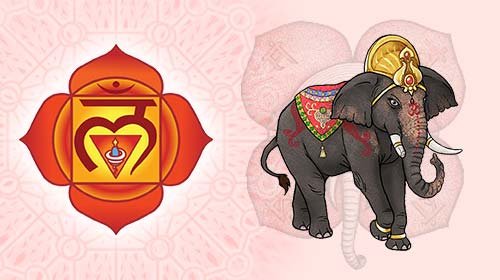
The inverted triangle indicates the downward flow of energy and is an alchemical symbol for earth, the element associated with this chakra. The triangle embodies the attribute of stability because it carries the anchoring energy of the first chakra.
The four petals of the root chakra lotus represent stability and structure in addition to the four mind-states: Manas (mind), Buddhi (intellect), Chitta (awareness), and Ahamkara (ego). Since the root chakra is the beginning point, the four-petaled lotus as a whole represents the genesis of human awareness.
The square represents foundational life energy, rigidity, and stability. The number four repeats again here as a four-corner symbol, representing foundational life energy.
This number represents foundations and a sturdy building, since the square has four sides. A healthy root chakra provides a stable foundation for opening the other chakras.
The letter inscribed is LAM, the beej mantra of the Root chakra.
The symbolic animal of the Muladhara chakra is the Elephant. Elephants can communicate by sending seismic signals, which cause vibrations in the earth that elephants can feel with their bones! This relationship to the earth element and the force of gravity connects the elephant to the sense of safety, stability, and steadiness that resonates with the root chakra.
The location of the root chakra is at the base of the spine. It is accountable for our sensation of safety and security inside ourselves and in the world. This core assists us in being centered, grounded, and linked to our bodies and the material world. The meaning of the Sanskrit word Muladhara is “root,” “base,” or “foundation.”

The circles symbolize the cyclical process of birth, death, and rebirth. Since it contains more than one circle, the sacral chakra enhances this relationship. Since the sacral chakra and the water element are all about flow, a well-balanced third chakra will enable you to flow with the ebbs and flows of life and maintain emotional control through difficult times.
The six petals are another element of the sacral chakra symbol’s significance. To open and cleanse the second chakra, you must conquer the following six bad qualities: wrath, envy, cruelty, hate, pride, and want.
The crescent moon represents cycles, perpetual change, turmoil, and continuous motion. While the moon famously completes cycles every month, the crescent moon at the bottom of the inner circle is another sign of cycles. Thus, this serves as a further reminder that life is comprised of unending change and perpetual mobility, making emotional wellness crucial.
The letter inscribed is VAM, the beej mantra of the Sacral chakra.
The symbolic animal of the Swadhisthana chakra is the Fish. Their movement seems easy due of its smoothness. The capacity to go from the rigidity of the earth element into the fluidity of the water element is what distinguishes the Fish as the linked sacral chakra animal. It changes and adapts, which implies that the basic lesson of Swadhisthana is that development cannot occur without the capacity to let go and generate flow.
The solar plexus chakra is located around one inch above the navel in the upper abdominal. It governs our self-perception, confidence, bravery, and resolve. The name Manipura in Sanskrit means “city of gems.” The solar plexus carries the motivation to take action and make things happen; hence, this energy area is the custodian of the means to realize our ambitions.
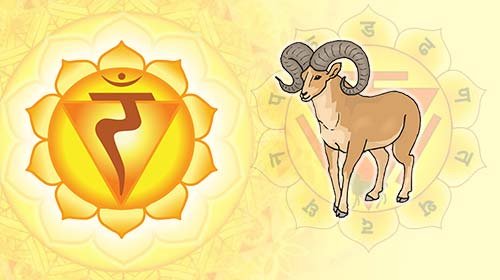
The solar plexus chakra is comprised of an inverted triangle surrounded by ten petals. These symbolize the ten pranas present in each of us (better described as energy currents or vibrations).
The inverted triangle illustrates how the solar plexus chakra collaborates with the root and sacral chakras to bring energy toward the ground. This is especially prevalent in the solar plexus chakra, since a link to the physical environment is essential for pursuing ambitions and achieving life objectives.
The ten petals symbolize the ten forms of subtle energy (vayus) or the ten obstacles to overcome: sadness, foolishness, delusion, disgust, fear, shame, treachery, ambition, jealousy, and ignorance.
The letter inscribed is RAM, the beej mantra of the Solar Plexus chakra.
The symbolic animal of the Manipura chakra is the Ram. The Ram represents the capacity to know oneself, express oneself, and establish oneself in the world. It is the transforming energy of self-expression that metaphorically unites the solar plexus chakra awareness with the Ram. When one transitions from solidity to fluidity, they begin to tap into their passion and spark their internal fire, recognizing it is time to take action.
Anahata roughly translates to “unstruck” or “unharmed” in Sanskrit, alluding to the Vedic idea of unstruck sound, the music of the heavenly world. This chakra is also related to healing, equilibrium, and tranquility. It also has the good characteristics of happiness, appreciation, compassion, and forgiveness.

Inside a circle, the Heart chakra symbol consists of two overlapping triangles making a six-pointed star. Twelve petals compose the exterior of a green lotus flower.
The two crossing triangles form a hexagram with a six-pointed star in the middle. These geometric forms symbolize the harmony between yin and yang and between the physical and the spiritual. Being the connection between the bottom three chakras and the top three chakras, the heart chakra has an equal mix of upward and downward traveling energy.
The twelve petals of the heart chakra symbolize the good attributes connected with this energy center: peace, happiness, love, harmony, empathy, understanding, purity, clarity, compassion, unity, forgiveness, and kindness.
The combination of the six-pointed star inside the circle and the twelve petals indicates the 72,000 energy channels or “Nadis” that every individual has. This is one another reminder of the heart chakra symbol’s significance.
The letter inscribed is YAM, the beej mantra of the Heart chakra.
The symbolic animal of the Anahata chakra is the Bird. A certain aspect of a bird in flight represents freedom and the power to climb above. A bird gliding through the air with ease indicates the free spirit and openness associated with cleansing the heart chakra. The awareness may be represented via the opening of the heart. Action has been taken, and connections are now possible as relationships emerge.
The throat chakra sits at the center of the throat (the front of the neck). It is our center of communication, allowing us to speak our truth, use our voice to express our beliefs, opinions, and creativity, and listen to others. The Sanskrit word Vishuddha means “purity,” as this energy center purifies our communication abilities.
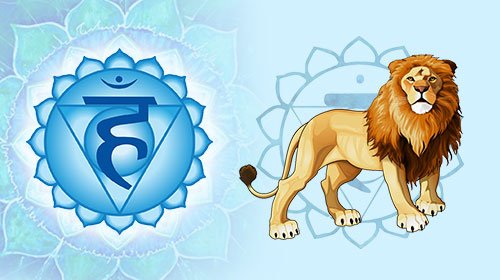
The throat chakra symbol consists of a circle within an inverted triangle within another circle. Around the outer ring is 16 petals.
The inner-circle represents the full moon, the lunar phase of resting, releasing, and letting go.
The inverted triangle that contains the full moon represents a channel to our consciousness and soul. As the throat chakra is one of the upper chakras, the energy starts to move upwards, closer to the spiritual realm.
The Sixteen petals are the Sanskrit vowels. Sanskrit vowels have a light and airy sound, relating to the effortless quality of communication you experience with an open and well-balanced Vishuddha chakra.
The letter inscribed is HAM, the beej mantra of the Throat chakra.
The symbolic animal of the Vishuddha chakra is the Lion. According to the WWF, lions are the only animals who roar together, have the loudest roar of any large cat, and their roar can be heard from 5 miles away. That’s communication! The lion’s intrinsic capacity to communicate with such strength metaphorically ties the lion with the awareness of the throat chakra. The throat chakra is all about vibration, sound, and the capacity to communicate your truth truthfully.
The third eye chakra is located between the eyebrows and is our intuition and imagination center. This energy center enables us to recognize signals and omens from the cosmos, therefore directing us in the proper direction. It also improves our ability to listen to our inner knowledge and is related to our imagination, perception, dreams, and psychic talents. The name Ajna means “perceive” or “beyond knowledge” in Sanskrit.
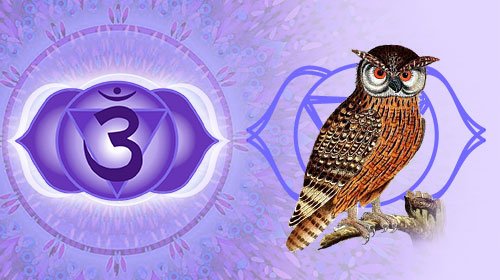
The third eye symbol consists of a downward-pointing triangle inside a circle and two petals.
At the center of many variants of the third eye symbol is the Om symbol. Om is the Bija mantra for the Ajna chakra, expressing spiritual connection and enlightenment.
The triangle points downward to signify that through activating the lower six chakras, the third eye may be activated.
The two petals symbolize the Ida and Pingala subtle energy pathways, which go up and down between the root chakra and the crown chakra. It represents the duality of the self and God.
The letter inscribed is OM, the beej mantra of the Third Eye chakra.
The symbolic animal of the Ajna chakra is the Owl. Your ability to connect with your higher self may be facilitated by developing your wisdom and intuition, which are represented by the owl animal. The eyes of the owl represent one’s capacity to see through deceptions and get access to one’s own self-awareness. It is because of this capacity for observation that the owl is the animal for the third eye chakra.
The crown chakra is located right above the crown of the head and appears as a floating energy ball (or crown). It signifies a divine connection associated with kundalini energy that ascends from the root chakra to the crown, culminating in transcendence and enlightenment. For many individuals, this is the most difficult chakra to open.
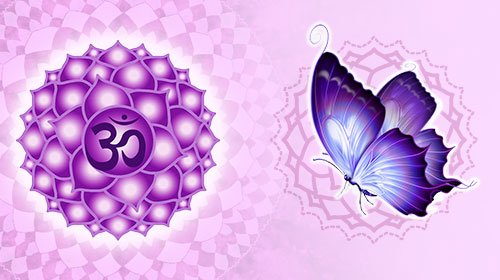
The Sanskrit term for the crown chakra, Sahasrara, translates to “thousand-petaled,” hence the emblem for the crown chakra symbol comprises many petals to signify this. This symbol’s circle depicts the full moon and the culmination of a cycle, signifying openness and waking.
This flower depicts our connection to the divine and our oneness with the cosmos. The lotus blossom represents prosperity and wealth.
The circle is a worldwide symbol of an unlimited and cyclical nature; it is limitless, similar to the nature of energy. It is viewed as a full moon and signifies our connectedness with others and ourselves.
The letter inscribed is AUM, the beej mantra of the Crown chakra.
The symbolic animal of the Sahasrara chakra is the Butterfly. The Butterfly embodies the etheric quality of the crown chakra, which is characterized by its lightness, delicacy, and easy ability to fly above and beyond all constraints. The butterfly is a sign of enlightenment, rejuvenation, and change, all of which are congruent with the awareness of the crown chakra since this chakra is responsible for connecting one with their divinity and the knowledge of the universe.
The chakra symbols are sacred geometric forms whose focus facilitates the alignment of each chakra. Similarly to how a yantra is the geometric form of a mantra and focusing on its core links us to the deity represented by its shape, visualizing and focusing on the symbols of the chakras promotes their opening, relaxation, and fluidity. When the symbols are paired with colors and the beej sounds of each chakra, chakras that were out of balance, hyperactive or underactive may be harmonized again. The upward flow that results from the harmonious activation of these energy centers, from the root chakra to the crown chakra, is progress in personal development and means the spiritual healing of all the energy centers.

The Root Chakra also known as the Muladhara Chakra, is placed between the anus and the genitalia at the base of the spine. It is comprised of the feelings of survival, stability, aspiration, and independence.
The Swadhisthana Chakra also known as the Sacral Chakra, is placed around four fingers below the navel in the lower belly. It has the fundamental urge for sexuality, as well as creativity and self-esteem.
The Manipura Chakra is placed between the navel and the bottom of the rib cage, near the solar plexus. It is marked by feelings such as ego, power and self-empowerment.
The Anahata Chakra is placed in the heart area, as its name indicates. This chakra is the seat of equilibrium and is characterized by the feelings of love, attachment, compassion, and passion.
The Vishuddha Chakra is situated at the base of the neck, where the thyroid gland is located. It is related to inspiration, healthy expression, faith, and the capacity for effective communication.
The Ajna Chakra is located between the eyebrows. Often referred to as the Third Eye Chakra, it is frequently utilized as a focus point during asana practice to cultivate greater attention and awareness. It is stated that focusing on this chakra removes past-life karma and grants emancipation and intuitive understanding.
The Sahasrara Chakra is located at the top of the head. Spirituality, enlightenment, and dynamic thinking and energy are centered in the seventh chakra. It permits the inner flow of knowledge and bestows cosmic awareness.
Using the chakras of the body, Reiki may offer extraordinary health and energy advantages. By working with Reiki Chakra Symbols and Reiki to balance your chakras, you may receive multiple advantages, including greater physical vigor, relief from chronic pain, better mental clarity, deeper sleep, and expanded self-healing powers.
Keep in mind, while practicing Reiki (reiki chakra symbols), that your chakras are positioned at different locations along the Nadis, the major energy channel of your body. This implies that you must utilize reiki touch treatment to unblock particular chakras in order to clear certain energy centers.
Cleaning and balancing each chakra may enhance your health and well-being as a whole. You may use Reiki to connect with your natural energy centers. These centers act as reservoirs of good chi or energy, allowing us to maintain balance and harmony in our lives. When you have access to these materials, you will have access to potent instruments for self-healing and spiritual development.
Reiki may help you reach mental and physical energy balance. Reiki may also aid you in gaining access to your own inner strength by removing negative energy blockages from your chakras.

